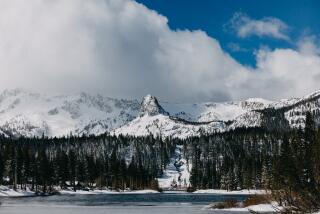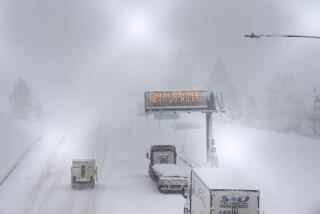Winter’s blast costs millions of dollars
- Share via
An arctic cold snap rolled into California on Friday, dropping the snow level below 1,000 feet, destroying millions of dollars in crops and leaving a rare dusting of snow in unexpected places, including Montclair, Chino and even downtown Riverside.
Forecasters said it would only get colder this weekend. The National Weather Service predicted record low temperatures in the 30s across the Los Angeles Basin and Orange County, the 20s in parts of the San Fernando and San Gabriel valleys and the teens in the Antelope Valley and parts of the Inland Empire.
Because of the potential for sustained below-freezing conditions, the weather service on Friday issued a freeze watch through Sunday morning for the San Fernando, San Gabriel and Santa Clarita valleys as well as the Santa Monica Mountains. Officials urged residents to keep pets inside and consider moving potted plants indoors.
Gov. Arnold Schwarzenegger declared a state of emergency Friday, ordering the state to make 11 National Guard armories, fairgrounds and other facilities available as emergency centers and for use as shelters for the homeless.
Some social services groups were trying to spread the word to transients and elderly people without heat that they can go to the emergency centers. In Los Angeles, about 1,800 additional shelter beds are available.
The cold snap has already hit the Central Valley hard, with farmers there and in the Southland struggling to protect their crops.
Limoneira Co., Ventura County’s largest lemon producer, sustained severe damage to crops in the San Joaquin Valley early Friday and was bracing for more losses Friday night, said senior vice president Alex Teague.
The company lost about 25% of its crop in Porterville on Thursday night and expected to lose the rest of it Friday night, Teague said. The firm has 2,000 acres of lemons in Porterville, and its losses there could reach millions of dollars, Teague said.
Work crews were expecting to patrol Limoneira’s 4,500 acres of lemons and avocados in Ventura County throughout Friday night and into tonight, he said. They planned to irrigate trees throughout the night and run wind machines, he said.
But if temperatures drop low enough, all efforts may be futile, said Teague, a fifth-generation rancher.
“If you are at 25 degrees longer than four or five hours, you can mainly try to protect the tree so it will bloom again next year,” he said.
Citrus crops were particularly vulnerable to damage, and the California Farm Bureau Federation estimated that 75% of navel oranges and 70% of lemons -- crops worth $1 billion -- are still on the trees. But officials said other crops are also in jeopardy, including artichokes in Monterey County, lettuce in Imperial County and strawberries in Ventura County.
Farmers scurried to fill wind machines with propane and set out orchard heaters before the sun went down. Some were dragging out old smudge pots.
Ventura County strawberry grower Bill Reiman said pockets of cold air Thursday night had damaged some of the delicate crop, although he had no estimate of losses.
Like other farmers, Reiman was heading home at midafternoon Friday to catch a nap, anticipating a long night ahead.
“It’s usually one night that’s a real threat, and then it’s over,” he said. This time, he said, Friday night and tonight “are equally threatening. It’s ominous.”
Forecasters said Friday provided a sample of the cold temperatures and frosty conditions the weekend would bring.
Children at grade schools in Fontana rolled boulder-sized snowballs across the playground Friday, and some residents couldn’t believe what they were seeing.
“I thought I was still dreaming,” said Tracy Chell, 52, a Fontana resident who woke up to a hailstorm that turned into a flurry of fat snowflakes about 7 a.m.
“Everyone came out to look. I’m a kid at heart, so I was jumping around and dancing.”
As flakes of snow landed near downtown Riverside, UC Riverside students tried to remember the last time they had seen snow in the area.
“I think I was in the sixth grade,” said 22-year-old Kendrick Hawkins. “It’s been a while.”
Kelly Redmond, regional climatologist for the Desert Research Institute in Reno, said that, based on weather data going back to 1949, the cold spell was one of the more severe in more than half a century.
It was also unusual because the huge cold-air mass was too far inland to be influenced by moderating coastal winds and the ocean. The result was nearly unadulterated and untamed arctic air, Redmond said.
Jamie Meier, a meteorologist for the National Weather Service in Oxnard, said record lows are possible tonight and especially overnight Sunday, when downtown Los Angeles could break a cold record.
“The record for Sunday is 37 degrees, and we’re forecasting 35 for Sunday,” Meier said.
William Patzert, a meteorologist for the Jet Propulsion Laboratory in La Canada Flintridge, said the cold snap is particularly curious given that Southern California posted record highs, in the 80s, earlier this week.
“We were talking global warming and heat waves with Santa Anas, and now we’re talking about all those farmers maybe losing oranges and lettuce or whatever because of the cold,” he said.
Farmers were hoping that this would not be a repeat of 1998, when a cold wave caused more than $700 million in crop losses, or 1990, when it got so cold that trees were irreparably damaged and the effect on crops lasted two seasons.
Then there was 1963, when worldwide cold weather resulted in many records that still stand in Southern California.
San Joaquin Valley orange grower Gerald Denni said he remembers his parents’ battle to save their crops that year, as well as the aftermath.
“They used smudge oil or low-grade diesel fuel in a smudge pot or a heater,” Denni said. “They typically had 50 of those per acre, and it created a lot of black soot and smoke. I remember the black haze hanging over the valley floor.”
In the Ojai Valley on Friday evening, Lisa Brenneis and her husband, Jim Churchill, raced to wrap their small citrus and avocado orchard in freeze-protection fabric. At sunset, they were hurriedly wrapping rows of fragile tangerine trees with the billowing white fabric.
“You live with the consequences for a long time when you have a freeze,” Brenneis said.
“We didn’t want to replant,” she said. “We kissed the avocados goodbye yesterday and started concentrating on other things.”
catherine.saillant@latimes.com
Times staff writers Jonathan Abrams, Sara Lin, Jennifer Delson and Rong-Gong Lin II contributed to this report.
*
(BEGIN TEXT OF INFOBOX)
Coping with the cold
Here are some tips provided by state and local officials about dealing with the cold weather:
* Wear layers of loose-fitting clothes, such as thermal underwear, sweaters, sweat shirts, sweat pants and socks, to trap body heat.
* Open drapes to let the sun heat your home during the day and close them at night to help insulate your home.
* Close off unused rooms and the vents that heat those rooms.
* Move furniture around so you are sitting near interior walls instead of exterior walls and windows.
* Close your fireplace damper tightly when not in use.
* Never use your range or oven to heat your home, and never use a barbecue grill in your home or garage.
* Put space heaters on level, hard and nonflammable surfaces, not on carpets or rugs.
* Keep space heaters at least 3 feet from bedding, drapes, furniture and other flammable materials.
* Never leave a space heater on when you go to sleep or leave the area.
* When the temperatures dip, pets and potted plants should be moved inside.
Here are some symptoms of exposure to the cold:
* Confusion, dizziness, exhaustion and shivering are signs of hypothermia. If you experience any of these symptoms, seek medical attention immediately.
* Gray, white or yellow skin discoloration, numbness and waxy skin are symptoms of frostbite. If you experience any of these symptoms, seek immediate medical attention.
* In case of overexposure to freezing temperatures, remove wet clothing and immediately warm the body with a blanket or fluids like hot cider or soup. Avoid caffeine and alcohol.
Source: Times reports, State Department of Community Services and Development
*
On the web
A list of cold weather armories opened by the state can be found at https://gov.ca.gov/index.php/press-release/5114/
More to Read
Sign up for Essential California
The most important California stories and recommendations in your inbox every morning.
You may occasionally receive promotional content from the Los Angeles Times.















